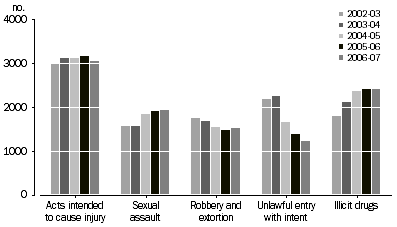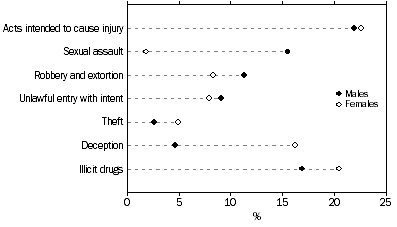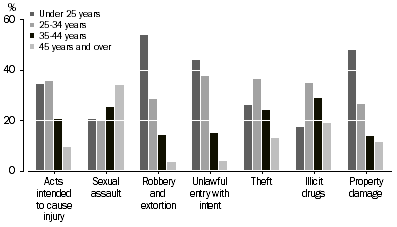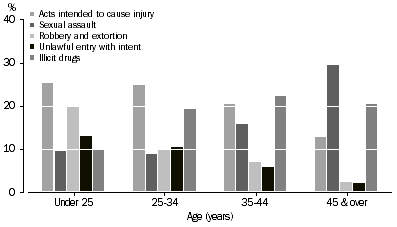PRINCIPAL OFFENCE
The following information only relates to defendants who were adjudicated, i.e. finalised via a plea of guilty or a decision by the judge as to their guilt or innocence of the final charges laid. The offence categories referred to relate to the principal offence i.e. the most serious offence type with which the defendant was charged. For more information about principal offence see the Explanatory Notes paragraphs 38-41.
Five offence types accounted for nearly three-quarters of defendants heard in the Higher Courts: acts intended to cause injury (22%); illicit drug offences (17%); sexual assault (14%); robbery and extortion (11%); and unlawful entry with intent (9%). Between 2002-03 and 2006-07, these five offences have accounted for the largest number of defendants charged.
Although the number of defendants decreased 4% since 2002-03, the number charged with an offence of illicit drugs or sexual assault increased during this period (up 33% or 602 and 23% or 367 respectively). Defendants charged with weapons and explosives offences also increased (by 205% or 121 defendants) during this period. However, defendants charged with this offence account for a relatively small proportion of adjudicated defendants (1% in 2006-07). The number of defendants charged with unlawful entry with intent decreased by between 2002-03 and 2006-07 (down 43% or 929).
DEFENDANTS ADJUDICATED, Selected principal offence, 2002-03 to 2006-07

Sex
In 2006-07, defendants were more likely to be male (87%) than female (12%). The two most common offences that both males and females were charged with were acts intended to cause injury (22% and 23% respectively) and illicit drug offences (17% and 20% respectively). For males, this was followed by sexual assault (16%) and for females it was deception (16%). There was a similar pattern of offences during 2005-06.
DEFENDANTS ADJUDICATED, Selected principal offence by sex

Age
Those aged 25 to 34 years accounted for just under a third (31%) of defendants charged in the Higher Courts. This was followed by defendants aged under 25 years (30%), and those aged 35 to 44 years (22%). Defendants aged 45 years and over represented 16% of defendants.
Of defendants charged with robbery and extortion, unlawful entry with intent, property damage, and public order offences, the largest proportion of defendants were under 25 years of age. Of those charged with acts intended to cause injury, theft, and illicit drug offences, the largest proportion of defendants were aged 25 to 34 years. For sexual assault offences, just over a third (34%) of defendants were aged 45 years and over.
DEFENDANTS ADJUDICATED, Selected principal offence by age groups

A quarter (25% each) of defendants aged under 25 years and 25 to 34 years were charged with acts intended to cause injury. While robbery and extortion accounted for 20% of defendants aged under 25 years, this offence type was less common for defendants over this age group. The largest proportion of defendants aged 45 years and over were charged with sexual assault (29%) followed by illicit drug offences (21%).
DEFENDANTS ADJUDICATED, Age groups by selected principal offence

Proven guilty
In the Higher Courts, 81% (11,345) of defendants plead guilty. Defendants charged with weapons and explosives offences or unlawful entry with intent were more likely to have plead guilty (96% and 91%) than those charged with homicide (47%) and sexual assault (61%).
Of the 2,507 defendants that had a trial outcome (acquitted or found guilty by the court), 44% were acquitted. Four offences accounted for just under three-quarters of all trials; sexual assault (30%); acts intended to cause injury (21%); illicit drug offences (12%); and homicide (9%). Defendants charged with sexual assault were more likely to be acquitted at trial (57%) than found guilty, whilst defendants charged with illicit drug offences were less likely to be acquitted (20%).
 Print Page
Print Page
 Print All
Print All